
Botanical Name : Panax notoginseng (Burk.) F. H. Chen
Medicinal Chinese Name : Sanqi
Primitive: The root of Panax notoginseng (Burk.) F. H. Chen of Araliaceae plant Araliaceae.
Use location : Root
Main origin : Mainland China
Production place: Distributed in Jiangxi, Hubei, Guangdong, Guangxi, Sichuan, Yunnan and other places in mainland China, mainly produced in Yunnan, Guangnan, Guangxi.
Harvesting and processing: Generally harvested after 4 years of planting, harvested from August to September or called Spring 7 and November. Dig up the roots, remove the stems and leaves, and dry or dry.
Medicinal Latin Name : Radix Notoginseng
Sanqi medicinal properties
Sanqi: The roots are conical, spindle-shaped or irregularly shaped, 3~4cm long and 0.4~3cm in diameter. The surface is grayish yellow to brownish black, with waxy luster, root rhizome marks on the top, nodular protrusions around it, intermittent longitudinal wrinkles on the sides and root fractures. The body weight is firm, the skin is often separated from the wood after crushing; the cross section is grayish green, yellowish green or grayish white, the skin has fine brown resin road spots, and the center has a slightly radial texture. The gas is slight, bitter, slightly cool and then sweet.
Sanqi organization identification
The outermost layer of the root cross section is 5~8 layers of cork layer. The outer layer cells are easy to rupture, and the cork cells are rectangular. The phloem is scattered with several resin channels and the diameter is about 80~250μm. The formation layer is obvious, 3 to 4 columns. The xylem is composed of a duct, a thin-walled cell of the wood, and a medullary medulla; the medullary ligament is 1 to 3 columns. Most of the catheters are mesh catheters and stepped catheters. The outer tough vascular bundles are arranged radially. The center is the native xylem. The soft cells contain a large amount of starch granules, and the starch has a particle size of about 5-15 μm.
Sanqi HPLC fingerprint
Test liquid and sample preparation method
(1) Internal standard solution (I.S) configuration
0.1 g of acetophenone was placed in a 100 mL dosing bottle and made up to the mark with 70% ethanol (Ethanol) as an internal standard solution (I.S.).
(2) Extraction method
The medicinal materials of Panax notoginseng were powdered by a pulverizer, and 1 g of powder was weighed into a 50 mL centrifuge bottle. After adding 8 mL of 70% ethanol (Ethanol) aqueous solution, the ultrasonic wave (Bornson 5210/8510) was shaken for 15 minutes to Hermle. Centrifuge the Z-400 centrifuge at 2500 RPM for 10 min, take the supernatant, and add 8 mL of 70% Ethanol to the residue for 15 minutes. Repeat three times. The three supernatants were combined, and 1 mL of the internal standard (acetophenone) was added, and the volume was adjusted to 25 mL with 70% Ethanol as a detection solution.
Chemical fingerprinting
(1) Calibration of common fingerprint peaks
Take HPLC to detect the HPLC chromatogram obtained from the medicine of Panax notoginseng, and calibrate the time and relative time of the peak of each batch of Panax notoginseng (refer to the peak time of occurrence of the internal standard IS time), as the drug must have a peak Reference basis
(2) The ratio of the total fingerprint peak to the retained area
The chromatogram of the samples of Panax notoginseng was determined by HPLC, and the relative retention area of each finger peak was calculated. The absolute retention area of each finger peak was divided by the absolute retention area of the internal standard (I.S.) as the relative retention area of the finger peak. The relative retention area of each finger peak is divided by the relative retention area of the reference finger peak (the reference peak relative to the retention area is selected, and the peak area is relatively large and stable). The relative retention area and reference material of each finger peak are calculated. The ratio of the peak relative to the retained area is taken as the ratio of the peak relative retention area.
(3) Chemical fingerprint radar map production
Absorb the finger peak map, mark the peak time of each finger, calculate the average value of the relative area ratio of each finger peak of the medicine, and obtain the S.D value and the corresponding compound number. The peaks in the HPLC map are numbered as the outer circle coordinates, and the relative area ratio of the finger number is the value of the coordinate axis, and the value of ±S.D is marked to make a simple and clear chemical fingerprint radar map.
Panax notoginseng contains ginseng saponins Rb1, Rd, Re, Rg1, Rg2, Rh1 (ginsenoside Rb1, Rd, Re, Rg1, Rg2, Rh1), esculenta, notoginsenoside R1, R2, R3, R4, R5 , R6 (notoginsenoside R1, R2, R3, R4, R5, R6), α- and β-ylangurene (α-, β-muurolene), cyperene, γ-, β- and γ- Elemene (α-, β-, γ-elemene), α-gurjunene, guaiene, caryophyllene, α-cedrene, Cuparene, cadinene, β-cubebene, methyl palmitate, ethyl palmitate, methyl heptadecadienoate, octadecadiene Methyl ester (methyl octadecadienoate), palmitic acid, heptanoic acid, octanoic acid, nonanoic acid, and the like.
Sanqi velvet root contains ginseng saponin Rb, ginseng xVI (gypenoside XVI), notoginsenoside R4. Panax notoginseng contains ginseng saponins Rb1, Rd, Re, Rg1, Rg2, Rh1 and notoginsenoside R1, R2, R, dencichine, a small amount of flavonoids, starch, protein, oil, biopterin And trace elements.
Sanqi plant description
Perennial perennial herb, 20~60 cm high. The main root is thick, fleshy, spindle-shaped, inverted conical or cylindrical, and the upper part often has a branching mark of the ridge. Stems single, erect, unbranched. Palmate compound leaves, 3-6 pieces of stalk apex; leaflets usually 5 to 17 pieces, 3 to 19 pieces thin, membranous, oblong to obovate-oblong, leaf margin with fine serrate, dentate Small bristles, sparsely bristled along the two sides. Umbells solitary, 3 to 4 cm in diam., with flowers 80 to 100 or more.
